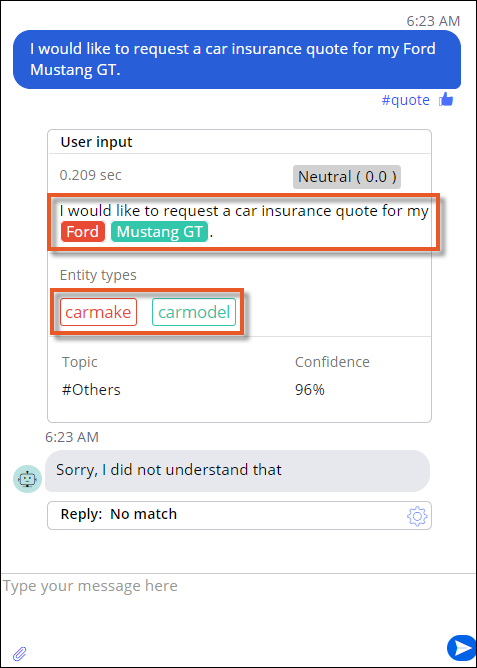Verifying chatbot responses
To ensure that Pega Intelligent Virtual Assistant™ (IVA) responds correctly to user requests during a chat session, you can first simulate conversations with the chatbot and then verify the responses in the preview console for a conversational channel. As a result, the system becomes more responsive and improves its text analysis and artificial intelligence.
For example, you can ensure that the system correctly detects topics and entities relating to car insurance, when a user asks for a car insurance quote in their chat session.- In the header of Dev Studio, click the name of the application, and then click Channels and interfaces.
- In the Current channel interfaces section, click the icon that represents your existing Alexa, Unified Messaging, or Web Chatbot channel.
- In the channel, click the Behavior tab.
- At the top of the preview console, turn on the Show analysis switch.
- In the preview console in the right panel, type in a typical user phrase that starts a business case.
- Correct the topic (subject matter) or entity detected in user input:
Choices Actions If no topic was found - Click Define topic below the entered text.
- In the Topic field, press the Down arrow key, and then select the correct topic, for example: insurance quote.
- In the field below the topic name, enter a sample of user input to associate with the topic.
- Optional: To add additional sample phrases to associate with the topic, click Add example, and then in the field below, enter the text.
- Click Submit.
If the wrong topic was found - Click the topic name located below the entered text, for example: #new hire.
- In the Topic field, press the Down arrow key, and then select the correct topic.
- In the field below the topic name, enter a sample of user input to associate with the topic.
- Optional: To add additional sample phrases to associate with the topic, click Add example, and then in the field below, enter the text.
- Click Submit.
If no entity was found - In the text section below the detected sentiment, highlight and right-click the text that you want to map to the new entity.
- Click New entity.
- In the Create new entity window, in the Entity name field, enter a name for the entity, and then click Submit.
If the wrong entity was found - In the text section below the detected sentiment, highlight and right-click the text for an existing entity.
- Click the name of another entity.To make sure the car make in the text maps to the CarMake entity, highlight and right-click Ford, and then click #CarMake.
- Click the Like icon next to the topic name located below
the entered text.Clicking this icon is important in the IVA training process, and improves the correct detection of topics.
- Click Save.
Previous topic Simulating a conversation and building a chatbot Next topic Modifying chatbot response questions

